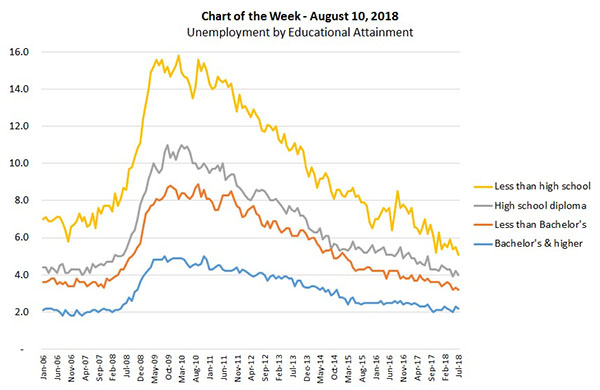
MBA Chart of the Week: Unemployment by Educational Attainment

Source: Bureau of Labor Statistics.
Our chart this week features unemployment rates by educational attainment, as of the Bureau of Labor Statistics’ July Employment Situation report.
Over the past 12 months, the unemployment rate for workers with less than a high school diploma decreased from 7.0 percent to 5.1 percent, a substantial drop. In contrast, the unemployment rate for workers with at least a bachelor’s degree was essentially unchanged, going from 2.3 percent to 2.2 percent over the same period. This may explain why despite healthy growth in payroll employment and a declining unemployment rate, we have yet to see a meaningful increase in wage rates on aggregate.
As employment increases for workers with high school diplomas, who tend to have lower hourly earnings than those with college degrees, and while older, higher-paid college educated workers leave the workforce, there will be downward pressure on aggregate wage rates. We also see this in the Atlanta Fed’s Wage Tracker, where wage growth for prime age workers (age 25-54 years) has outpaced overall wage growth for much of the post recessionary period. For the past 12 months leading up to July, the measure averaged 3.3 percent for all workers, but 3.5 percent for prime age workers.
This is good news for the housing market, as income growth may actually be faster than most aggregate measures have shown. Home price growth has been close to 7 percent over the past year, and with some markets starting to show signs of slowing, the increase in wage growth will help to close the affordability gap that the market has seen with accelerating home prices and increasing mortgage rates.
(Joel Kan is associate vice president of economic and industry forecasting with MBA; he can be reached at jkan@mba.org.)
